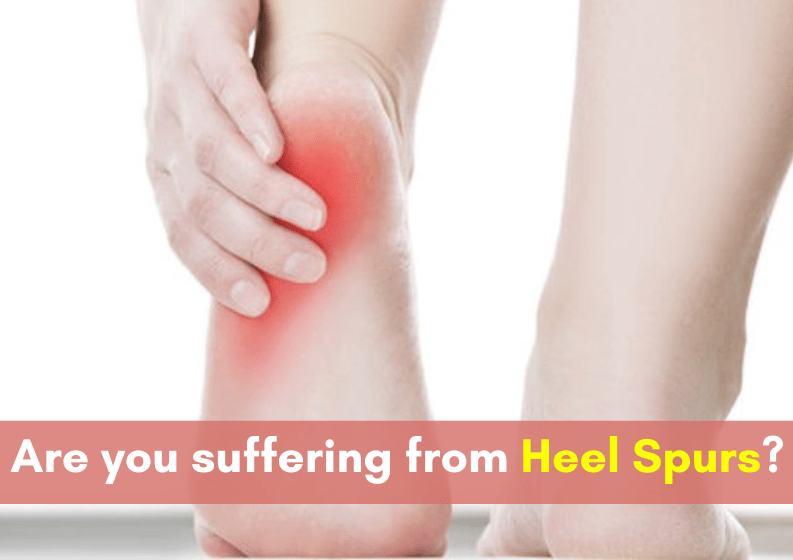A heel spur is a bony growth that develops on the underside of the heel bone, at the point where the plantar fascia attaches. The plantar fascia is a thick band of tissue that runs along the bottom of the foot, from the heel to the toes. It is often painless, but it can cause heel pain, especially when first getting up in the morning or after prolonged standing or walking.
It is essential to be clear that plantar fasciitis and heel spurs are two separate but often connected disorders. Heel spurs are bony outgrowths or calcium deposits that develop on the underside of the heel bone (calcaneus). It is caused by the build-up of calcium deposits over time. Whereas plantar fasciitis involves inflammation of the plantar fascia, a thick band of tissue that runs along the bottom of the foot.
Heel spurs often appear as small, pointed or hooked outgrowths on the underside of the heel bone. They can vary in size from a few millimeters to over an inch, and their presence doesn’t necessarily correlate with the severity of pain.
Causes of Heel Spurs
1. Plantar fasciitis: This is a condition that causes inflammation of the plantar fascia, a thick band of tissue that runs along the bottom of the foot from the heel to the toes.
2. Overweight or obesity: Carrying excess weight puts more stress on the plantar fascia.
3. High arches: People with high arches are more likely to develop because the plantar fascia is under more tension.
4. Flat feet: People with flat feet have less arch support, which can also put more stress on the plantar fascia.
5. Repeated stress on the heel: This can happen from activities such as running, jumping or standing for long periods of time.
6. Age: It is more common in people over the age of 40.
Old Treatment
1. Rest: Avoiding activities that put stress on the heel can help to relieve pain.
2. Ice: Applying ice to the heel for 20 minutes at a time several times a day can help to reduce inflammation and pain.
3. Compression: Wearing a compression bandage or sleeve around the heel can help to reduce swelling.
4. Elevation: Keeping the heel elevated above the level of the heart can also help to reduce swelling.
5. Medication: Pain relievers, such as ibuprofen or naproxen, can help to relieve pain.
6. Physical therapy: Physical therapy exercises can help to stretch and strengthen the plantar fascia and other muscles in the foot.
Advanced Prolotherapy Treatment for Heel Spurs
Prolotherapy is a minimally invasive injection treatment that is used to stimulate the body’s natural healing response. It is used to treat a variety of conditions, including heel spurs. Prolotherapy injections work by stimulating the body’s natural healing response. The injections contain a solution of dextrose (sugar), which irritates the tissue and causes an inflammatory reaction. This reaction triggers the production of growth factors, which help to strengthen and repair the ligaments and tendons.
Prolotherapy has been shown to be effective in treating heel spurs in a number of studies. A 2018 study published in the journal Pain Medicine found that prolotherapy was effective in reducing pain and improving function in people with heel spurs. The study participants received a series of four prolotherapy injections over a period of four weeks. The results showed that the prolotherapy group had significantly greater pain relief and improvement in function than the control group, which received the same injections.
Prolotherapy is a safe and effective treatment option for heel spurs. It is a minimally invasive procedure that does not require surgery. The injections can cause some mild discomfort, but most people experience no serious side effects.
Shockwave Treatment and EMTT Therapy
Shockwave therapy is a non-surgical, non-invasive procedure that uses high-energy sound waves to break up scar tissue and stimulate the body’s natural healing process. Shockwave therapy works by stimulating the body’s natural healing process. The sound waves cause micro trauma to the tissue, which triggers the release of growth factors and other substances that promote healing.
Benefits of Shockwave and EMTT Therapy for Heel Spurs
1. Non-invasive procedure, which means there is no cutting or incisions involved.
2. Relatively painless.
3. Reducing pain and improving function.
4. Can be used to treat other conditions, such as Plantar Fasciitis and Achilles tendonitis.
These therapies are a safe and effective treatment option for heel spurs. It is a good choice for people who are suffering from other chronic pain conditions.
Conclusion
Heel spurs may be a difficult condition to have but people might benefit from the excellent treatment provided by Dr. Vikram Rajguru, a regenerative orthopedic surgeon in Pune. His innovative regenerative therapy has helped many patients in overcoming their struggles with chronic pain caused by heel spurs. His method designed specifically for people affected with many orthopedic conditions has shown remarkable success in easing the pain and improving their mobility.
To learn more about regenerative treatments provided by the Prolotherapy clinic, Please contact us at 7507501241, 9049046867, 7507503736 or visit the website www.theprolotherapyclinic.com

